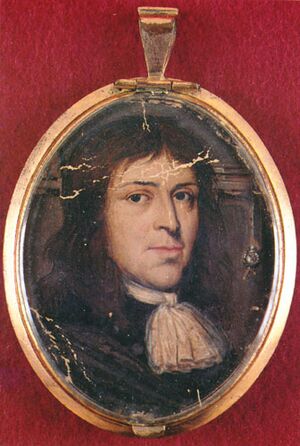Samuel Parris facts for kids
Quick facts for kids
Samuel Parris
|
|
|---|---|

Portrait of Samuel Parris
|
|
| Born | 1653 London, England
|
| Died | February 27, 1720 (aged 66–67) Sudbury, Massachusetts, U.S.
|
| Alma mater | Harvard College |
| Known for | Father and uncle of Salem witch trials accusers; accuser along with his daughter and niece |
| Spouse(s) |
Elizabeth Eldridge
(m. 1680; died 1696)Dorothy Noyes
(m. 1699) |
| Children | Thomas Parris Elizabeth Parris Susannah Parris |
| Relatives | Abigail Williams (niece) |
Samuel Parris (1653–February 27, 1720) was a Puritan minister in Salem Village, Massachusetts, during the famous Salem witch trials. Accusations made by his daughter and niece against an enslaved woman started a series of witchcraft accusations that grew very quickly.
Contents
Samuel Parris: A Look at His Life
Early Life and Career
Samuel Parris was born in London, England, in 1653. His family had some money and were Protestants who did not follow the main Church of England.
In the early 1660s, Samuel moved to Boston. He went to Harvard College because his father wanted him to. When his father passed away in 1673, Samuel left Harvard. He went to Barbados to take over his family's property, which included a sugar plantation.
In 1680, a big hurricane hit Barbados and damaged much of his property. Samuel sold some land and moved back to Boston. He brought his enslaved woman, Tituba, with him. In Boston, he married Elizabeth Eldridge. They had three children: Thomas, Elizabeth Parris, and Susannah.
Even though his plantation helped him with his business, Samuel Parris was not happy with his money situation. He decided to become a minister. In 1685, he worked as a minister in Stow, Massachusetts, for a short time.
Minister in Salem Village
In July 1689, Samuel Parris became the minister of Salem Village. This area is now known as Danvers. Salem Village was a difficult place to live. People in nearby towns knew it was often full of arguments.
Samuel Parris was the fourth minister to try and stay in Salem Village for a long time. The previous ministers, James Bayley and George Burroughs, left because the church members did not pay them fully. Deodat Lawson also left.
There were many disagreements about how much Parris should be paid. In October 1691, the town decided to stop paying him. These problems, and other personal fights among the villagers, continued to get worse.
The Salem Witch Trials Begin
The events that led to the Salem witch trials started in Parris's own home. His daughter, Betty, and her cousin, Abigail Williams, accused Parris's enslaved woman, Tituba, of witchcraft.
Parris pressured Tituba until she said she was a witch. Then, John Indian, Tituba's husband, also started accusing other people. These accusations spread quickly. Many people were arrested and put in prison. During the 16 months of the Salem witch trials, many people were accused. Sadly, 19 people were put to death, and Giles Corey also died.
In a sermon in 1692, Parris told his church that there were "devils" among them. He encouraged the villagers to find and stop "witches." Often, the people accused were those with whom Parris and his friends, the Putnam family, had disagreements.
After the Trials
Because Samuel Parris was very involved in the witchcraft cases, his church brought charges against him in 1693. Parris apologized in a written essay called Meditations for Peace in November 1694. A church meeting, led by Increase Mather, then cleared his name.
Parris then had another argument with his church members. This time, it was about land that he had taken to pay himself the salary he felt he was owed. A court in Ipswich decided in 1697 that his salary should be paid, and the land should be given back.
By 1696, Parris felt he could no longer stay in Salem. He resigned that year and left. Records show he likely went back to business in Boston in 1697.
His wife, Elizabeth, died in 1696. In 1699, he married Dorothy Noyes in Sudbury. He preached again for a few years in Stow. Then he moved to Concord around 1704 or 1705. He also preached for six months in Dunstable in 1711. Samuel Parris died on February 27, 1720, in Sudbury.
Samuel Parris in Stories
Samuel Parris appears in many stories about the Salem witch trials.
He is a character in Arthur Miller's famous play The Crucible, written in 1953. This play is about the witch trials. In the play, his daughter Elizabeth Parris is one of the first to become ill from supposed witchcraft. Actors Jean Debucourt and Bruce Davison played him in the 1957 and 1996 movie versions of the play.
Author John Neal also included Parris in his 1828 novel Rachel Dyer. This was the first full novel about the witch trials. In this book, his name is Matthew Paris, and he is a lonely character.
Parris is also a character in the 1964 novel Tituba of Salem Village by Ann Petry. He also appears in the 1986 novel I, Tituba: Black Witch of Salem by Maryse Condé. Both books tell stories about the witch trials.
In the novel Supernatural: One Year Gone, Parris is shown as being tricked by real witches into starting the trials. He also tricked the girls into accusing his enemies. At the end of the book, he promises to stop harming innocent women.
Road to Endor, written in 1940 by Esther Barstow Hammand, uses facts from Parris's life to create a fictional story. The book follows Samuel's life from his birth up to the time of the trials.

